Do you struggle to manage your time effectively and stay productive?
It turns out, you’re not alone. Only 20% of people feel they have control over their daily workload. This also impacts a company’s bottom line — research shows the US economy loses an astounding 50 million hours of productivity each day due to unrecorded work activities.
So, what can we do to change it? 🤔
The starting point is to track where all of this lost time goes.
While time tracking alone isn’t a magic solution to improving productivity and time management, the data can pinpoint where you spend the most time and where you should focus on improving daily work habits.
This article explores 30 time tracking best practices for freelancers, teams, and managers that help them make the most of their time.
14 time tracking best practices for individuals
Time tracking best practices are important for individuals like employees, freelancers, consultants, contractors, and solopreneurs. These best practices, individuals can help bill clients accurately, improve time management, and be more productive.
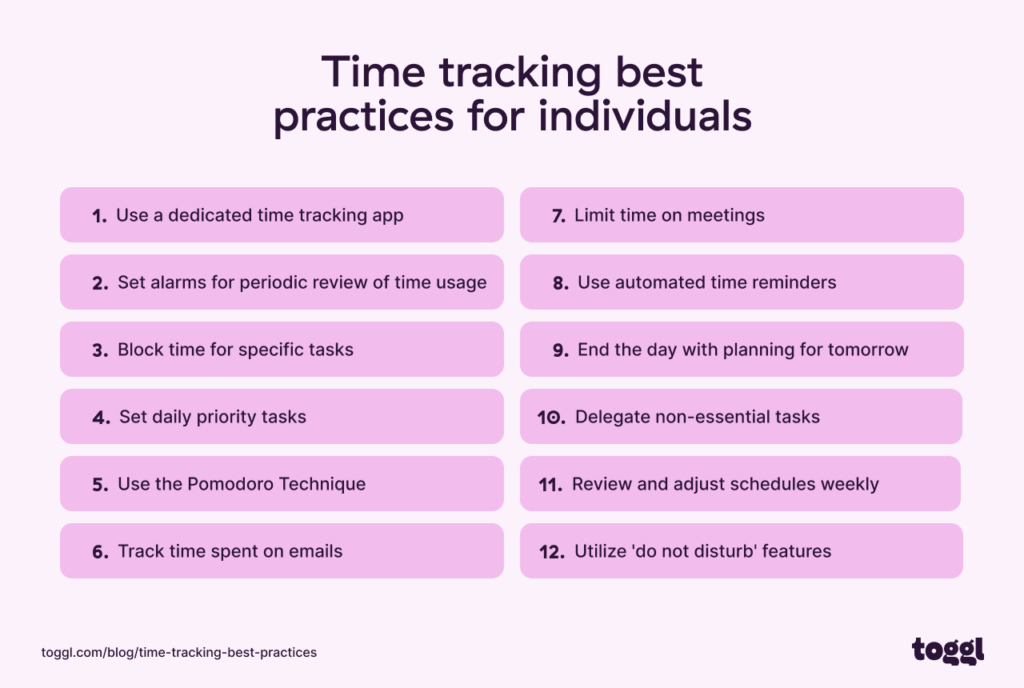
1. Use a dedicated time tracking app
Time trackers can be manual or automatic. A manual time tracking solution lets you add time entries or use a start/stop timer to record your time.
Automated time tracking tools run in the background, recording time spent on different tasks, websites, and apps to eliminate the need for manual entries.
A user-friendly tool like Toggl Track makes it easy to track time using the Timer or manual mode.
The Timer mode means all you need to do is start the timer to record your time.
To enter the Timer mode in Toggl Track, click the pink clock icon on the Timer page 👇

Then, track your time by clicking the pink play icon. You can fill in the Description, Project, Tag, or Client to organize your time entries.
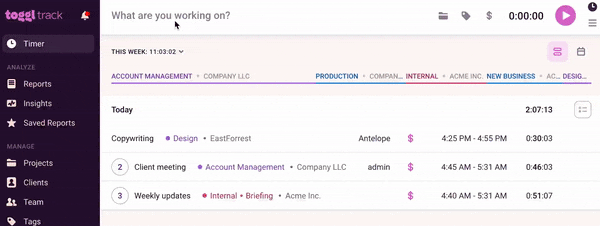
Toggl Track is available on the web, desktop, and through mobile apps, or via browser extensions.
The Manual mode lets you add tasks you have already completed. Just click the plus icon underneath the play icon:

Then, add your time entry details and click the pink plus button.

2. Set alarms for periodic review of time usage
Some team members may forget to start the timer, especially when building a new time-tracking habit. This can create gaps in time entries, inaccurate time-tracking data, invoicing, and billing.
To avoid this, set alarms to review time usage periodically.
Most time tracking tools have built-in features to send automated notifications to remind team members to log their time.
In Toggl Track, you can set time tracking reminders like this:
- Go to Workspace Settings and select the Reminders tab
- Click the New Reminder button in the top right corner
- Enter a weekly or daily target number of hours that team members should track
- Finally, click Create Reminder
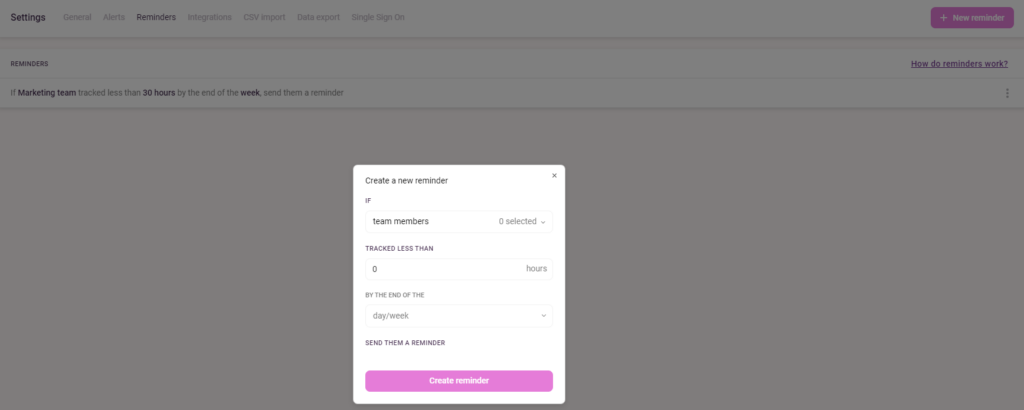
There is also an option to add multiple reminders (daily and weekly) for one team member or set up user group target hours.
3. Block time for specific tasks
Time blocking is a productivity method where you focus on one task at a time.
You can manage your workday more effectively when you allocate specific hours to different tasks.
Time blocking minimizes distractions, so it’s easier to finish tasks within set deadlines.
Toggl Track’s Calendar and Timeline features are perfect for blocking time for specific tasks. Simply organize your day or week by scheduling blocks of time for different tasks using the drag and drop tool.
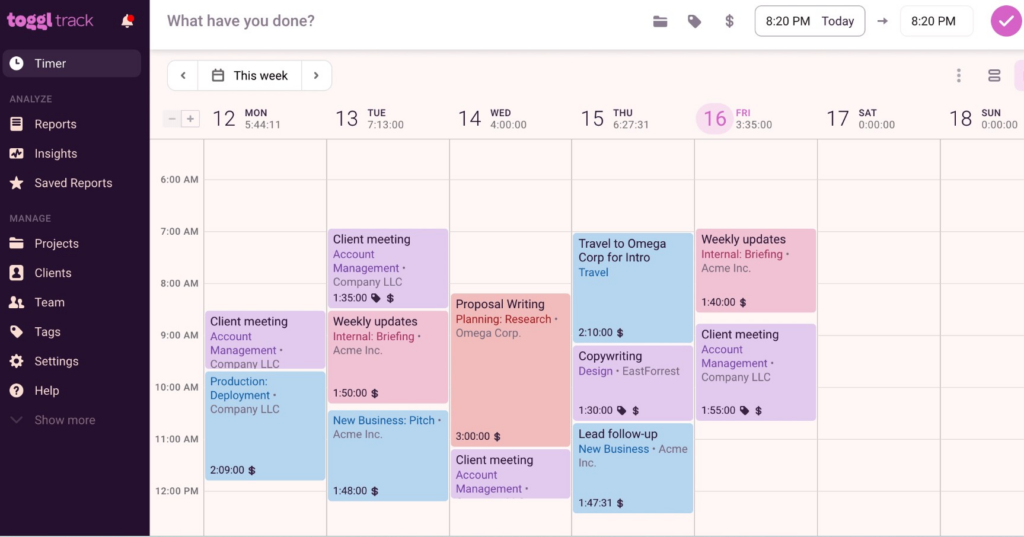
4. Set daily priority tasks
At the start of each day, identify the most critical tasks you need to complete to clearly understand your priorities.
For example, if you’re a freelancer, you may prioritize finishing a client project by noon to meet a deadline.
This helps you focus on and give your best efforts to high-priority tasks that impact your work most.
5. Use the Pomodoro Technique
The Pomodoro Technique involves working in focused intervals of 25 minutes followed by a five-minute break. After completing four Pomodoro intervals, you take a longer break of 15 to 30 minutes.
How does the Pomodoro technique help? 🤔
It breaks work into manageable segments to reduce mental fatigue and increase focus. It also encourages you to work with the time you have—rather than against it.
Toggl Track has a built-in Pomodoro timer. Access it using our custom extension or desktop and mobile apps.

6. Track time spent on emails
Most working professionals spend hours in their inboxes every day. It can be easy to overlook how much time this takes up.
For certain industries, like consultants and lawyers, tracking time spent on emails is important to keep records and billing accurate. It’s also easy to do with a tool like Toggl Track.
Here’s how:
- Users can track time using Toggl Track’s Chrome or Firefox browser extensions to capture every billable minute
- It also integrates with communication and email tools like Outlook Email, Gmail, Newsletter2go, or ProtonMail and tracks time accurately from inside their inboxes
7. Limit time on meetings
If you spend less time on lengthy, often unnecessary meetings, you can use that time for more productive tasks like working on a client project.
We recommend:
- Clearly define the meeting’s purpose and prepare an agenda to stay on topic.
- Adding tangible outcomes like a project decision or a follow-up action to every meeting you have.
- Keeping meetings as short and sweet as possible.
But if you do get into many meetings, make sure to track them. You’ll have a more accurate record of how you spend time, which can help you improve your work habits.
Toggl Track integrates with Google Calendar and Outlook to easily import meetings and online events directly into your Toggl Track calendar view.
Then, you can click on the calendar events you imported to turn them into time entries with just one click.
8. Use automated task reminders
By integrating automated task reminders into your daily routine, you can improve your productivity and avoid missing deadlines.
You can opt-in to receive automated timely alerts for upcoming tasks, deadlines, or meetings to keep your schedule on track.
For example, when creating a task or meeting event in Google Calendar, you can tick the Add Notification option. You’ll receive an email or pop-up notification at your specified time before the event.
9. End the day by planning for tomorrow
Planning and time-blocking tasks for the next day improves your chances of staying on track with your work. This practice organizes your tasks, reduces decision fatigue, and provides a clear action plan for the next day.
To improve her time management habits, Mercedes Soria, EVP and Chief Intelligence Officer at Knightscope, does 30 minutes of task planning every Sunday to prepare for the week ahead.
She explained to Forbes how creating a schedule in advance helps her use her time more efficiently and avoid distractions.
“By setting priorities and creating a schedule for the week ahead, I’ve found that I am using my time more effectively and efficiently. This helps me to avoid getting bogged down in low-priority tasks or distractions and to focus on the work that will have the most impact on my goals.”
10. Delegate non-essential tasks
Delegating tasks is common among managers and team leads who need to focus on more important projects.
Here’s how it goes: they identify non-essential tasks that don’t require their specific expertise and assign them to team members or external contractors.
Project managers can use the Eisenhower Matrix to prioritize high-impact tasks and delegate less important work.
The Eisenhower Matrix categorizes tasks into four quadrants based on urgency and importance: urgent and important, important but not urgent, urgent but not important, and neither urgent nor important.
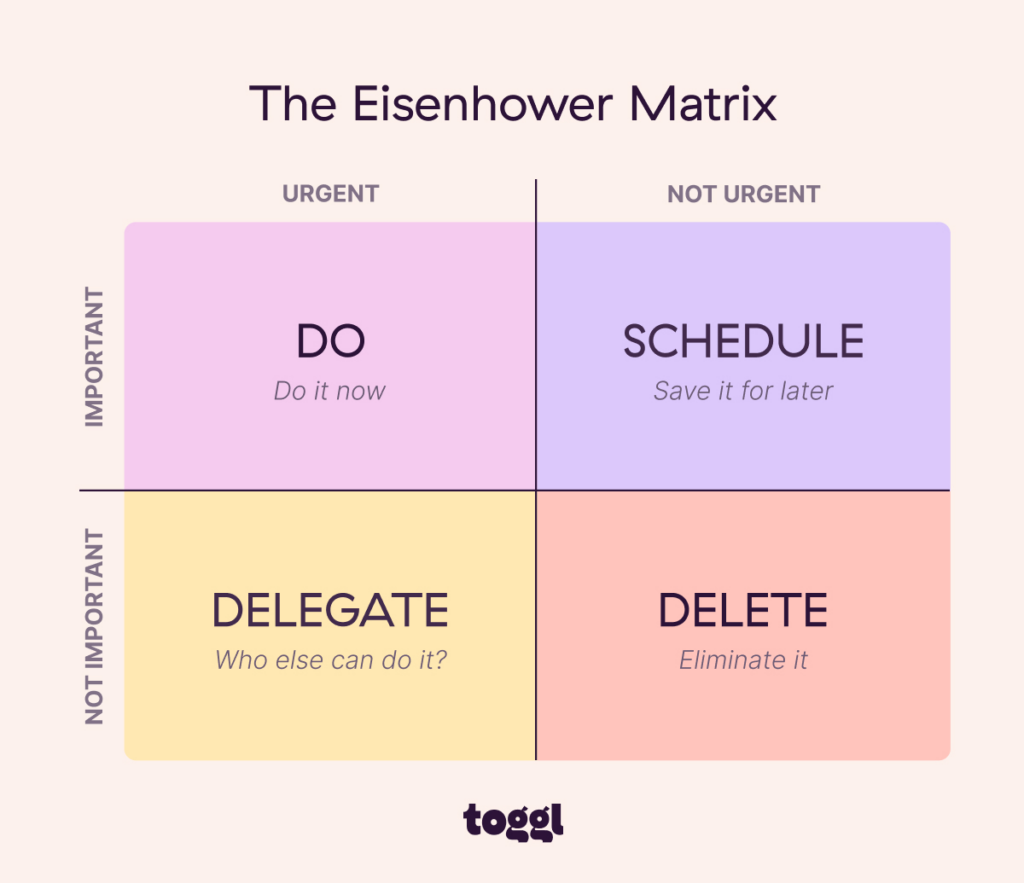
Delegating non-essential tasks is a win-win situation. It lightens the manager’s workload and empowers team members by providing opportunities to develop new skills.
11. Review and adjust schedules weekly
Regularly reviewing schedules allows you to assess task progress, rearrange priorities, and tackle unforeseen changes.
Updating and adjusting your schedule every week helps you stay aligned with goals and deadlines.
Toggl Track integrates seamlessly with Toggl Plan to make it easier to review availability, capacity, and booked hours and adjust schedules accordingly.
In Toggl Plan, you can group time slots visually using color-coded Gantt charts to organize projects and tasks more easily.
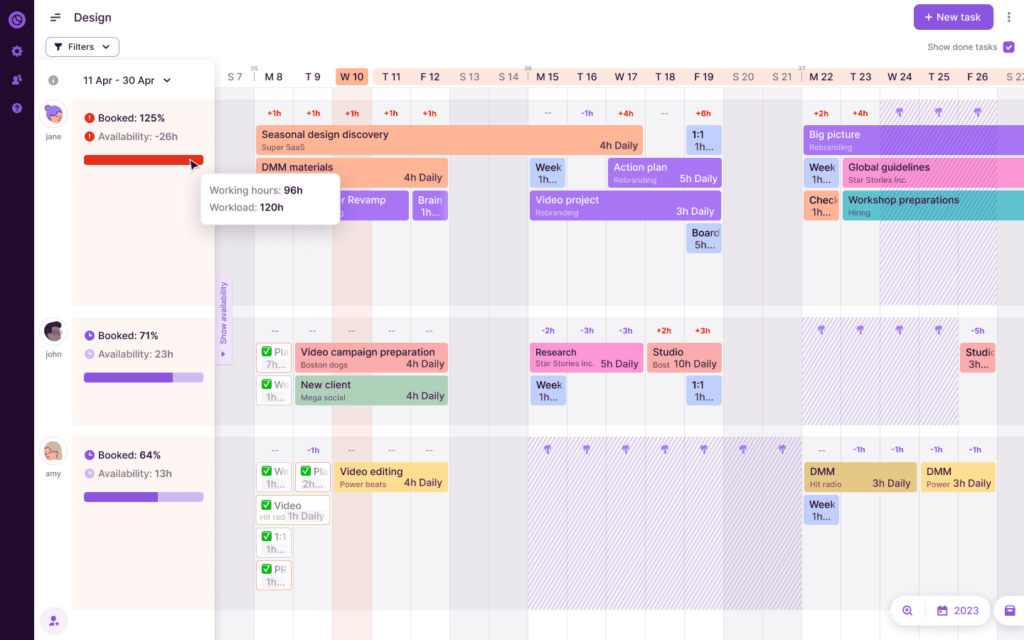
12. Use ‘do not disturb’ features
Distractions—from phones to social media—are everywhere. And they can hamper your time tracking habits.
To reduce distractions and maximize your productivity, use tools with distraction-blocking features.
For example, Toggl Track auto starts and stops focus sessions when the Pomodoro timer is on. This helps you to work in focused 25-minute sessions without being distracted by other apps or websites. When it’s time to take a break, the Pomodoro timer will notify you.
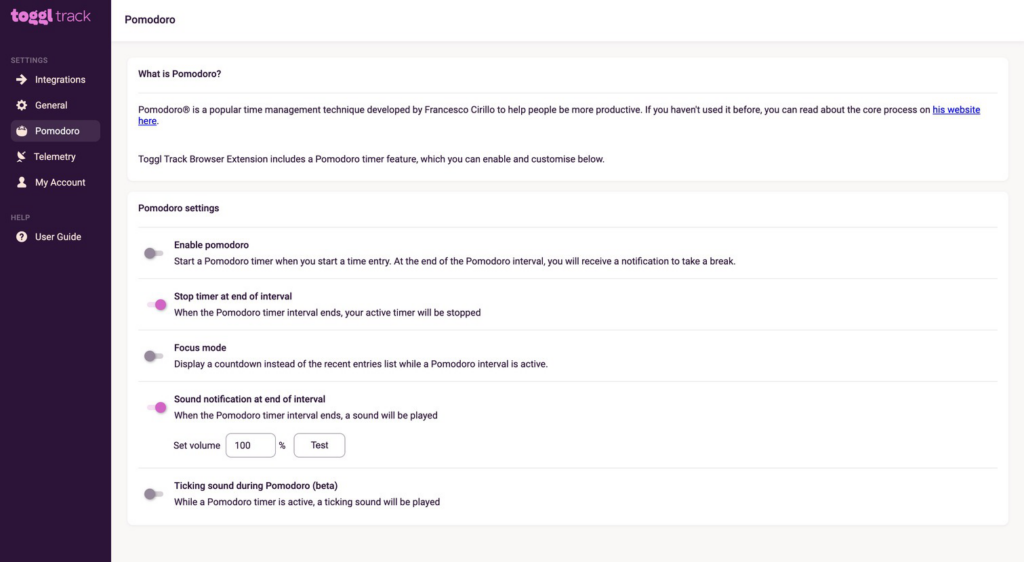
13. Prioritize tasks each morning
Start your day by prioritizing tasks. This involves reviewing your to-do list and identifying high-priority tasks that need immediate attention.
Techniques like the Getting Things Done (GTD) framework can help you focus on important work and avoid distractions.
The GTD framework consists of five steps:
- Capture all tasks
- Clarify their next actions
- Organize them by context
- Review them regularly
- Execute them effectively

To learn more about how you can use this framework to prioritize and be more productive, read our GTD deep dive article.
14. Break large projects into smaller tasks
High-performing teams and individuals break down large projects into smaller, manageable tasks to simplify and increase efficiency.
This method also makes it easier to track progress, spot potential problems early, and keep teams motivated.
You can use a Work Breakdown Structure to break down a project into manageable deliverables.
For example, you can break a website redesign project into specific stages: research, design, development, testing, and launch. Each component can then be subdivided into tasks, like creating wireframes, developing color schemes, and designing page layouts.
Toggl Track can organize your clients, projects, and tasks with user-friendly drag-and-drop functionality.
6 team time tracking best practices
Here’s how teams can improve their time tracking habits:

1. Track billable and non-billable hours
If you’re charging by the hour, tracking billable time is essential. It helps you bill clients accurately and transparently and avoid losing money.
However, tracking non-billable time is just as important to spot productivity gaps and bottleneck tasks.
Tracking billable and non-billable hours can be tricky without a time tracking tool.
Without one, it’s hard to distinguish between billable and non-billable hours, and you might even forget to track your time.
For example, Toggl Track lets you easily clock in and separate billable and non-billable hours to organize and understand work habits.
To make a time entry billable in Toggl Track, click on the $ symbol at the top of the page, as shown below.
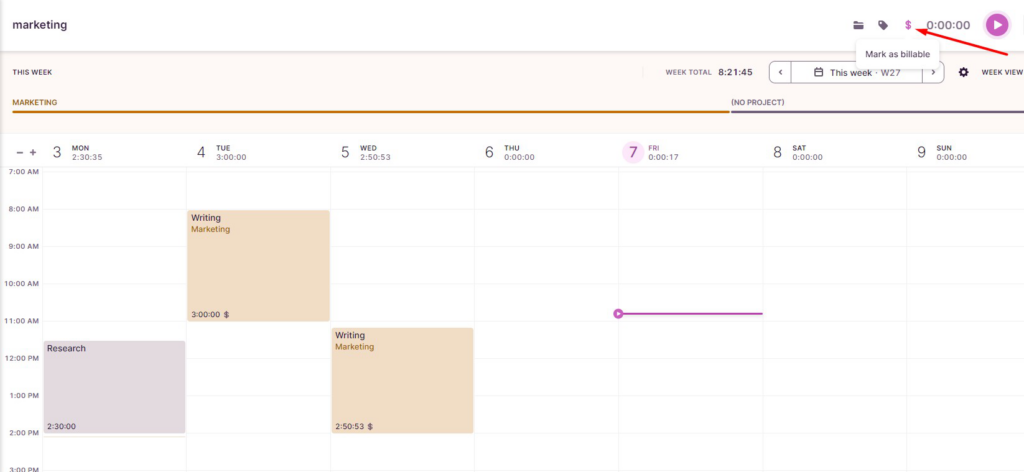
2. Use shared calendars
Teams can use shared calendars to collaborate better by visualizing schedules and workloads in real time.
Shared calendars also help avoid scheduling conflicts and track work progress in one place.
Toggl Track’s integration with Toggl Plan unlocks a shared team calendar and scheduling app. Teams can use it to plan and organize their team’s calendar in one place.
Using the Team Timeline, you can drag and drop tasks to reassign or reschedule them, add milestones, and plan projects realistically.
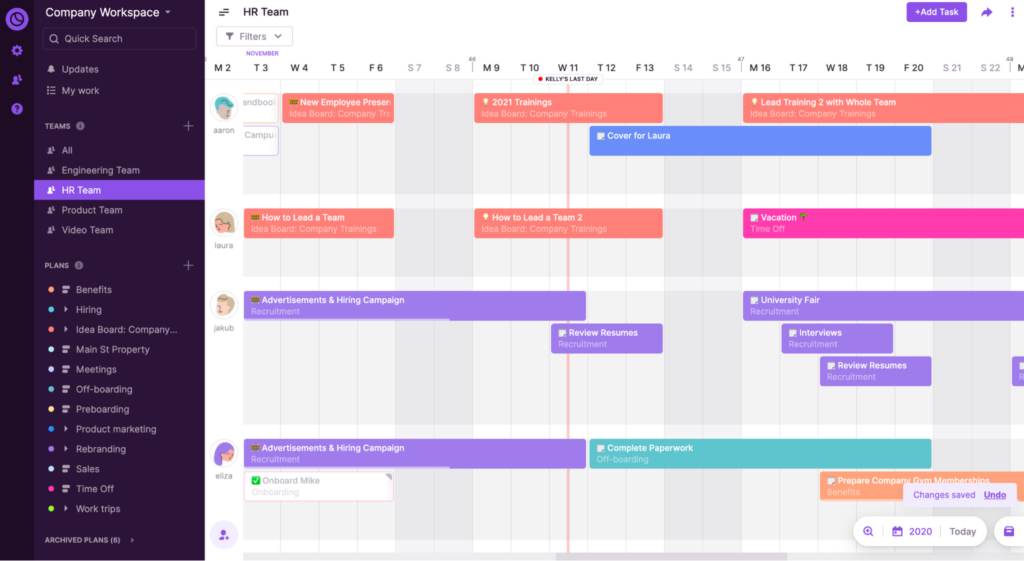
3. Regular check-ins on project timelines
Reviewing project timelines regularly helps spot bottlenecks and address delays before they become an issue.
A good practice is to set a consistent schedule for timeline check-ins, weekly or monthly, depending on the project’s length and complexity.
You can easily review project timelines using Toggl Plan’s integration with Toggl Track.
Timelines in Toggl Plan are easy to organize and manage with drag/drop tools and visual Gantt charts.
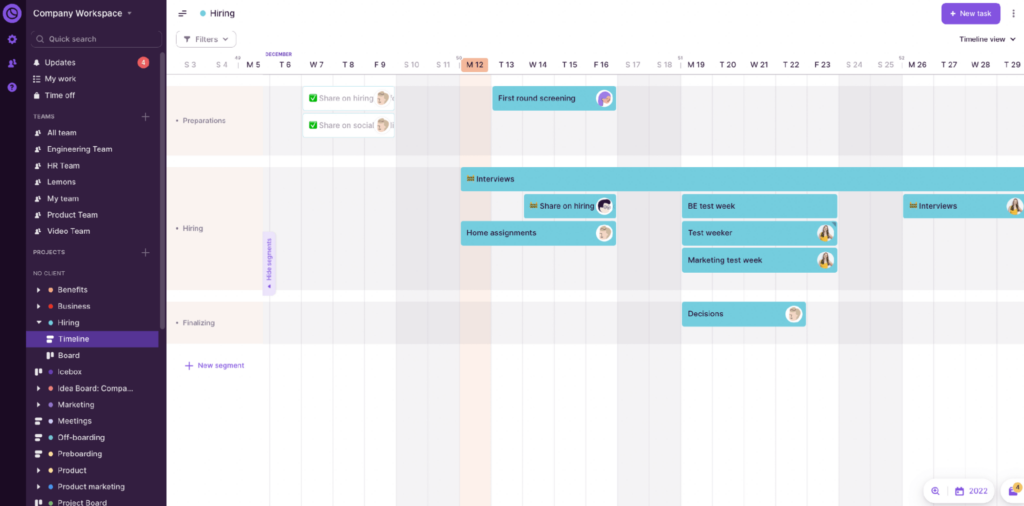
4. Collaborative project management tools
A project management collaboration software can enable real-time team collaboration and make teamwork easier.
Integrating your time tracking tool with collaborative project management apps has the following benefits:
- Team members log time on specific tasks within project management tools
- Avoid going back and forth due to constantly switching between apps
- Streamline time tracking to make it more accurate
Toggl Track natively integrates with popular project management tools like Toggl Plan, Asana, or Jira to make time tracking easier across different apps.
Integrating with Toggl Plan lets you start the time from your Toggl Plan workspace.

5. Track cost and profits
Monitoring project costs and profitability is easier when work hours are tracked. Time tracking data gathers valuable insights to paint a better picture of the financial health of your projects and business.
Toggl Track helps teams track costs and profits by allowing them to set labor costs and assess profitability.
Labor costs can be added for individual workspace members or project members to make sense of time tracking data and overall profitability.

This report can also compare income and expenses to determine how profitable different projects are.
6. Have someone check timesheets regularly
Reviewing timesheets ensures everyone logs their time accurately. A quick review can catch discrepancies and unlogged tasks to keep your billing accurate.
In Toggl Track, you can review and approve your team’s timesheets from the Team timesheets tab.
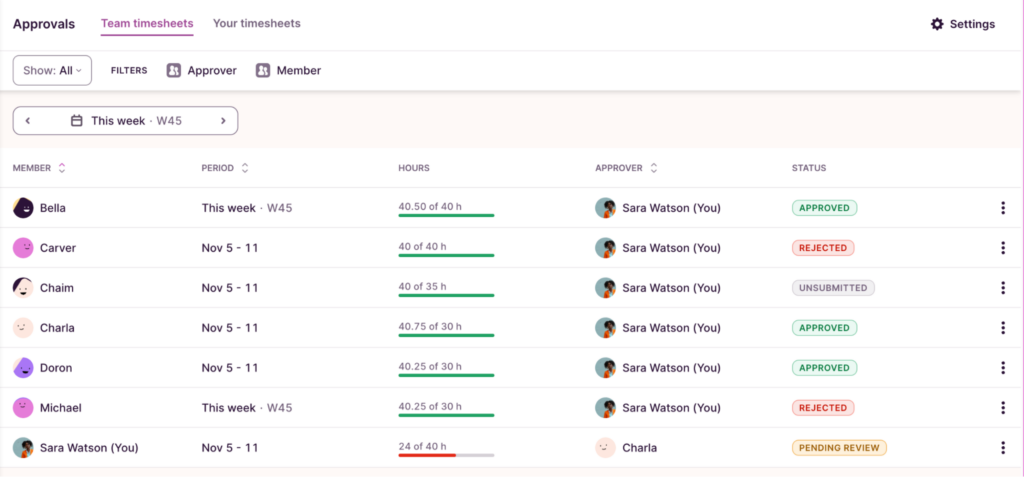
To access this tab, click on Approvals then select Team Timesheets.
You can edit, reject, or approve each timesheet by clicking on the 3-dot control next to it.

7. Encourage transparent communication about time use
Remind your team that the purpose of time tracking isn’t surveillance.
Time tracking should empower employees to be more productive and improve performance. It shouldn’t add stress or make them feel like they are being micromanaged.
To ensure transparency with time tracking practices:
- Communicate clearly and constantly about the role of tracking time
- Share time insights and reports with time tracking data with the team
Use these insights to collaborate with the team and change workflows.
9 time tracking best practices for managers
Here’s what managers can do to improve their team’s time tracking process and time management.
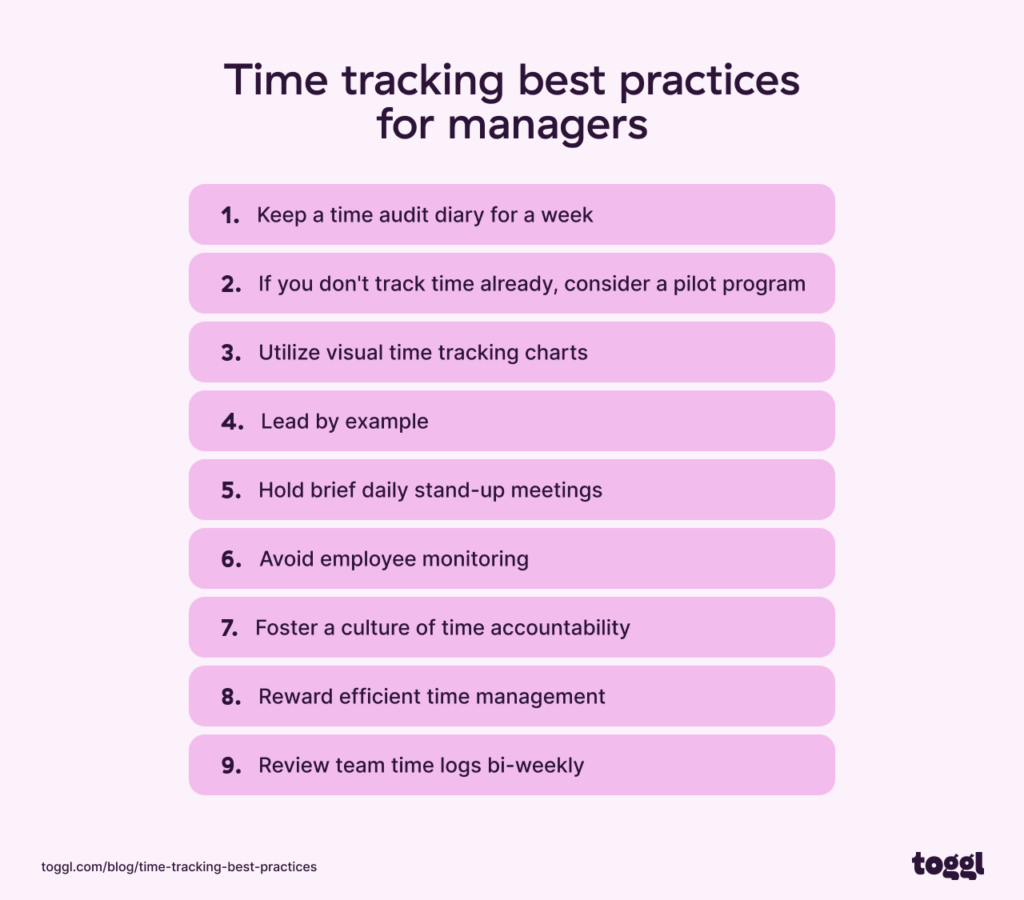
Here’s each one in detail.
1. Keep a time audit diary
Time audits track if time entries are attributed to the correct project to keep timesheets and reports accurate.
A weekly time audit diary helps spot incorrect time entries or those with suspiciously long durations.
Many managers avoid running time audits because they can be time-consuming, but Toggl Track makes the process much faster and more effective.
Here’s how to do it:
- Go to the Reports tab, Summary report, and head to the grouping list underneath the bar chart.
- Near the primary grouping button, click on the magnifying glass icon.
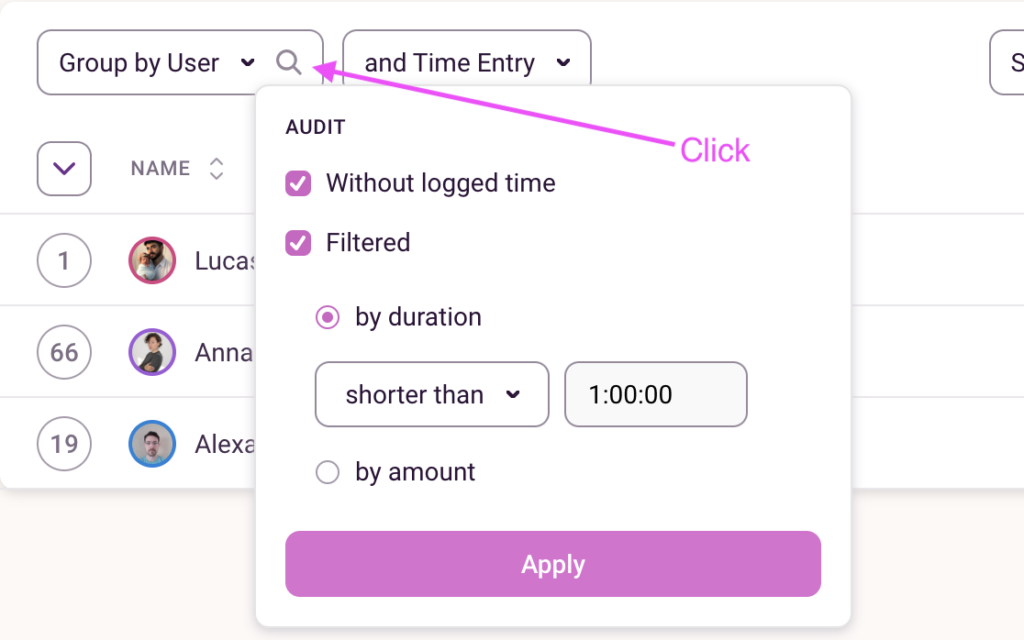
You can view users, projects, and clients without any logged time from here. It’s also possible to filter the audit by duration or billable amount.
Go to the Detailed Report tab and click the Audit button in the Filters bar to access time audits:

2. Consider a pilot time tracking pilot program
Testing your time tracking process using a pilot program before a full-scale rollout can help spot potential problems and gather feedback.
Choose a small group within your organization to test out a time tracking tool to see if there is any friction or concerns. Involving your team early also helps get buy in before moving to a long-term commitment.
To make your pilot program effective :
- Choose a diverse team and include team members from different roles, backgrounds, and levels of tech-savviness.
- Set clear objectives for this pilot program before you start, like assessing user experience or measuring the impact on productivity.
3. Use visual time tracking charts
The best way to use your time tracking data is with detailed reports that show productivity, profitability, time habits, and bottlenecks.
With Toggl Track’s detailed reporting features, you can create summary, detailed, or weekly time reports outlining your data in a visual, easy-to-understand format.
Let’s see how you can create a Weekly report in Toggl Track.
- Click on the Reports tab on the left sidebar and select Weekly from the top left of the screen.

- Choose a week by clicking any date within that week.
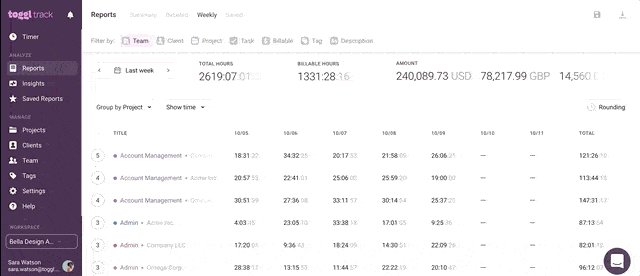
Another visual time tracking report that Toggl Track offers is the Project Dashboard.
You can access it from the Project Edit page.

From here, you can view:
- A forecast for project completion based on your project estimates
- The project’s progress against the fixed fee amount set for the project
You can also visualize your time tracking data with the Insights feature in Toggl Track.
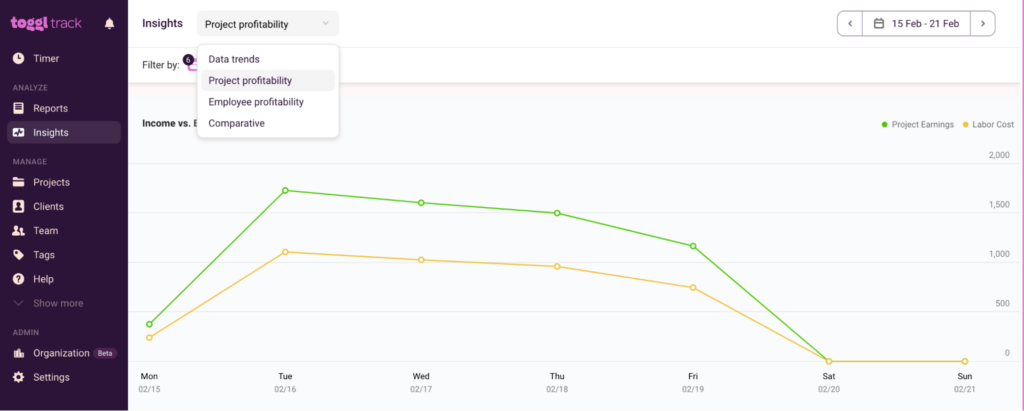
After you’ve added the labor cost for each team member, you get detailed insights into:
- Employee and project profitability
- Key data trends
A fully customizable and flexible way to dissect your time tracking data in Toggl Track is with the Analytics feature.

This feature consists of charts and dashboards that you can customize to show insights into team efficiency and productivity.
You can create your own visual time tracking charts and dashboards or use built-in templates to speed up the process.
4. Lead by example
If you’re trying to introduce time tracking to your team, starting to track your own time can encourage and speed up team adoption.
Go the extra mile and share some benefits you’ve experienced since tracking your time, like better time management or more productive work hours.
Your team may be more likely to trust and adopt the process if they see you lead by example.
5. Hold brief daily stand-up meetings
Short stand-up meetings to keep track of team progress and time allocation can keep everyone in your team on the same page.
Keep things short and sweet, and stay updated on your team’s tasks and plans for the day.
By doing this, you get a clear overview of your team’s workflows and keep employees accountable for their workday.
6. Avoid employee monitoring
One in four employees say workplace surveillance makes them uncomfortable. So, team leaders should think twice before (overly) monitoring a team.
Time tracking should be about improving time management and learning from time tracking data, not surveillance. Here at Toggl, have instilled this in our team with our anti-surveillance policy:

In short: we believe monitoring with screenshots and website activity tracking can damage trust, lower morale, and stress team members.
7. Foster a culture of time accountability
If you want to improve your team’s time management, prioritizing and focusing on time accountability is a great way to do it.
Do you value punctuality and healthy time management habits?
Live by these values, put them into practice, and foster a culture of personal responsibility for how to spend work hours.
8. Reward efficient time management
When people get time management right, don’t let it pass unnoticed.
Reward those employees who use their time efficiently. It doesn’t have to be anything groundbreaking. Acknowledging them publicly in meetings, giving performance bonuses, or additional time off is all it takes.
This not only helps team members keep up efficient time management—it encourages others to join.
9. Regularly review team time logs
Reviewing team time logs twice a week helps identify productivity gaps, limiting work habits and time waste patterns.
This best practice may sound like a lot of work, but it saves time in the long term. Then, you can take proactive measures to improve these inefficiencies and save time in the long term.
Toggl Track can help with this. Its Detailed reports give an in-depth look at where your team spends its time:
Common time tracking poor practices to avoid
Misusing time tracking can lead to frustration and lower efficiency, so here are some things to avoid when tracking time:
- Tracking time without a purpose: Logging hours without clear objectives can waste time and resources. Decide why you’re tracking time and what you want to gain from building this habit.
- Mistaking time tracking with micromanagement: Time tracking should empower, not suffocate. Excessively using it to control every minute of your team members’ day risks decreasing morale and productivity.
- Using complex time tracking systems: The more complex a time tracker is to set up and use, the harder it will be for your team to adopt.
- Not using time tracking data: Tracking time without analyzing data won’t lead to any impactful results. Use your time tracking data to improve time management and productivity.
- Discourage your team from taking breaks: Breaks are important for mental health and productivity, and everyone should take them daily.
How to implement the time tracking best practices
To make the most of all the best practices we’ve talked about so far, here are a few steps you can take:
Evaluate current practices
Take an honest look at your team’s current time management practices to identify major time wasters.
Some key questions to ask at his point are:
- What does the team do right in managing their time?
- What holds them back from maximizing their productivity?
- What could be improved?
- How could you help them improve their time management habits?
Set clear goals
Get a concrete idea of how you want your team to manage its work time, put it on paper, and clarify it.
Use goal-setting methods like SMART (Specific, Measurable, Achievable, Relevant, and Time-Bound) to help you narrow down your goals.
The most important thing is to define what needs to be accomplished and when so your team has a clear timeline to follow.
Use time tracking tools
Once your team knows what they need to do, it’s time to give them the right tools for the job.
Choose a time tracking software suitable for both individual and team use.
Your team will use this tool daily, so it needs to be intuitive and easy to use yet powerful enough to achieve your goals. Software that’s easy to set up out of the box will also speed up team adoption.
Train team members
Even if your new time tracking tool is easy to use, you still need to conduct training sessions to ensure:
- The whole team is proficient in using the tool
- The team knows how to track time accurately
Monitor and adjust
As with any process, reviewing and improving it will bring it closer to what the team and business need.
Use feedback from reviews to improve workflows, eliminate poor time management habits, and empower your team to be more productive.
Over to you
When done right, time tracking improves productivity and time management to help your team do its best work.
If you’re ready to Sign up for a free Toggl Track account, you’ll discover how it can help you:
- See where your time goes and be more productive
- Bill clients accurately
- Track progress and profitability
Related articles:
Work tools to elevate your productivity – apps for incredibly simple time tracking and effective project planning.






